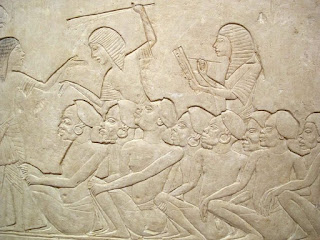 |
| Nubian prisoners of the tomb of Horemheb in Saqqara |
Tell el-Maskhuta was the first site excavated by the Egypt Exploration Society (Edouard Naville, 1.883). Prior to World War I, Jean Cledat conducted excavations, apparently largely in the temple precincts, which yielded numerous museum specimens but little of scholarly substance. More recently, the Egyptian Antiquities Organization, now the Supreme Council of Antiquities, has conducted numerous excavations in the northern cemetery, along the Ismailia Canal, and in a number of areas in and on the margins of the modern village. Most current knowledge of the site derives from a major series of surveys and excavations conducted by a multidisciplinary University of Toronto team directed by John S. Holla-day, Jr.
Recent Pages:
· Petosiris
· Sir William Matthew Flinders Petrie
· Petuabastis
· Philae
· Piety in Ancient Egypt
· Piramesse
